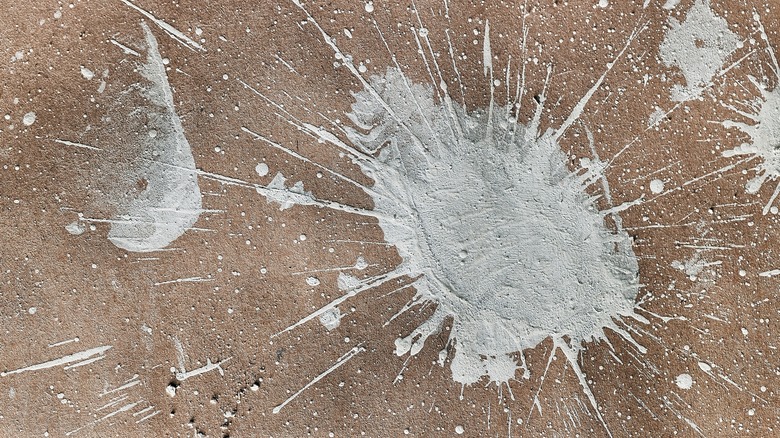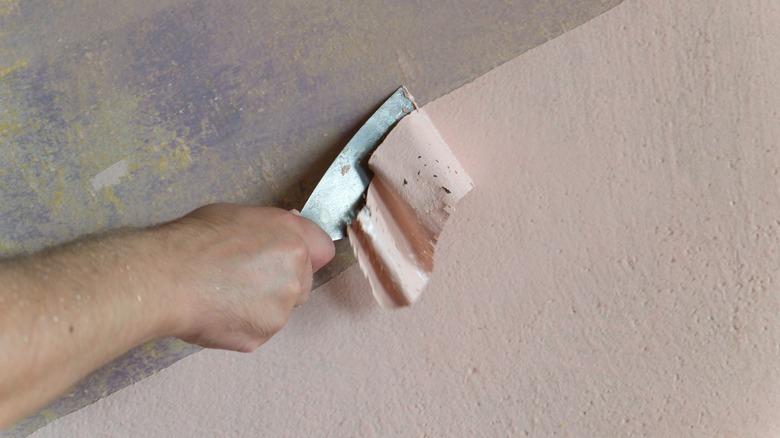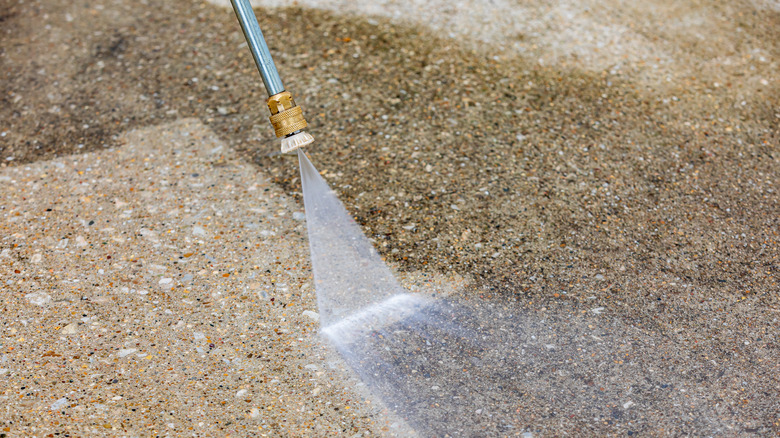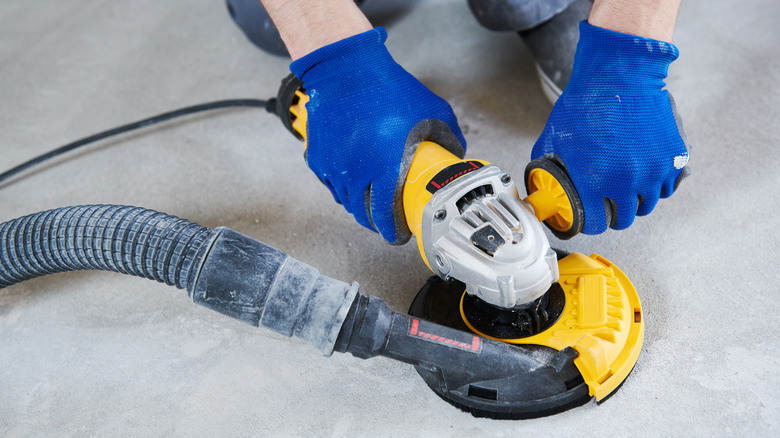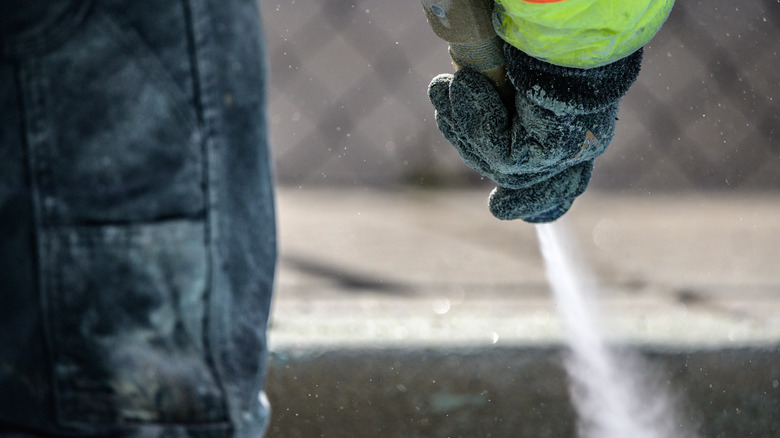4 Genius Ways To Remove Paint From Your Concrete Floors
If you have ever accidentally spilled paint on the floor, then you know the panicked feeling of having to clean up that mess as soon as possible in hopes that your mistake won't be a permanent one. Although paint spills on tiled floors or wooden laminate can be time-consuming, chances are that if you get to the mess right away and take care of it quickly, then you should be able to right your wrong with no issues.
However, when you spill on concrete, it can be a race against the clock. That is because concrete is a porous material, which means that water and other liquids are able to pass through the tiny holes in the hard surface, according to Dynamic Concrete Pumping Inc. So, unless your concrete flooring is polished or treated with a waterproof coating, chances are that the paint you spill could be absorbed. But that doesn't mean you have to stress out. Depending on how big the mess is and whether the paint is oil-based or water-based, there are luckily a few ways to remove that eyesore so that it won't become a permanent reminder of your sloppy slip-up.
1. Use a chemical paint stripper
When dealing with a larger job of removing old paint from a concrete floor, perhaps using a chemical paint stripper is the way to go. These types of products can include ingredients like benzyl alcohol and glycol acid that work to dissolve the paint so it can be easily removed. Because chemical paint strippers can have irritants, it is important to put on protective eyewear and gloves when working with the product (via Dumond).
The first step is to cover the area of the floor that has paint that needs to be removed. To apply the paint stripper, simply coat the floor using a large stain-friendly paintbrush up to ⅛ of an inch thick, according to Premier Veneers. This will allow the product to go to work without drying up. Also, to further prevent drying, you should place a sheet of plastic on top. This will ensure that the paint stripper stays on the surface for as long as possible. For best results, it's recommended that you leave it on the floor for up to 24 hours. Once the time is up, you can remove and dispose of the plastic layer, then start scraping off the stripper. Using a heavy-duty scraper while wearing your protective clothing, you should be able to easily remove the paint stripper, which can be thrown out in a garbage bag. Once finished, you can then power wash the surface to remove all of the chemicals or cleanse it with soapy water.
2. Try a pressure washer
If you are looking for an alternative to paint stripping chemicals, then maybe you should try a pressure washer to get that paint out of your concrete floors. A pressure washer is a machine that utilizes high-power hot water to aid in the removal of paint, rust, or stains from wood and concrete. Although the strength of a pressure washer can be a useful tool, you have to make certain that the setting is just right; otherwise, you might cause damage.
By adjusting the force of the water, you can make the stream more powerful. For stubborn paint spills or to just remove a painted portion of concrete, it is recommended that you use a range of between 2000 PSI to 4000 PSI, according to Garden Tool Expert. However, it can be a good idea to test this on a small surface of the concrete first to make sure that it isn't so great as to cause the material to crack or chip. When you are sure that you have the ideal setting, clear the area of any furniture or other objects. Then start spraying at a slight angle around 20 inches away from the surface and move the nozzle in a side-to-side sweeping motion. The pressure from the washer should be able to penetrate the porous concrete enough to extract the paint from the material. If possible, use this tool in warmer temperatures as it could have more success than when working in chillier surroundings.
3. Floor grinder
For a more direct approach to getting rid of paint on your concrete, a floor grinder can be just the thing to take care of the job. Although some of the above-listed methods can be quite useful, their processes may be more time-consuming than you would like. Using a floor grinder can speed up the job of removing paint, but you need to make sure you are working safely as this method can be both loud and dusty, according to Buy Manufacturers Direct,
A floor grinder is essentially a tool with a spinning coarse disc that scrapes off the top layer of the surface. This is an ideal process, especially if you are looking to add another coat of paint or alternative finish to the concrete afterward, as it can prep the area perfectly. Fortunately, these tools come with a vacuum-like hose in order to suck up the dust and debris that you are removing. But that doesn't mean that it's not a messy job. Residual dust can billow out as you are working, and since you have to be on the floor to use it, proper attire and safety equipment is a must. Protective goggles, safety gloves, dust masks, and even soft knee pads will ensure that you are kept safe and comfortable while you are working. Because this tool grinds down the surface, you want to avoid gouging divots by making smooth, even passes over the top layer so that you don't risk an uneven finish.
4. Soda blasting
Soda blasting is a more environmentally friendly method of paint removal that has been used successfully for quite some time. In fact, it is the exact process that was adopted to safely clean the grime, paint, and tar off of the copper surface of the Statue of Liberty in 1986, as per Popular Mechanics. Soda blasting works a lot like a pressure washer; however, instead of hot pressurized water coming out of a machine, it uses the power of sodium bicarbonate — otherwise known as baking soda — to blast onto concrete, metal, wood, or other surfaces to make them clean.
Although this process needs a special blasting machine to get the job done, it can be a great alternative to using harmful chemical cleaners. Operating these machines is much like a pressure washer as you need to make sure the surrounding area — like grass and plant life — is covered so that the baking soda doesn't soak in and possibly harm it. Proper personal safety gear must be worn, and you should blast in a sweeping motion evenly across the surface. This blasting process can also be used with sand or crushed walnuts, but these types of materials may be harsher than baking soda and could actually damage the concrete you are working on, according to Dustless Blasting. Baking soda is made from compounds that naturally work to lift grease, paint, and stains which is why it's so commonly used for cleaning clothes or other areas around the home.
